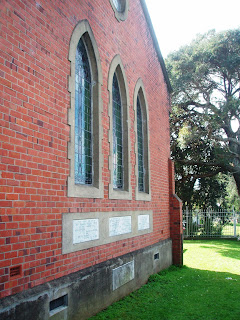The Ōtāhuhu Methodist Memorial Sunday School
The fine brick-and-tile Ōtāhuhu Methodist Memorial Sunday
School is a rare but impressive example of a Methodist war memorial building.
It stands behind the Ōtāhuhu Methodist church in Fairburn Road.
Ref: Bruce
Ringer, Ōtāhuhu Methodist Memorial Sunday School, 2013.
The
foundation stone, inset into the footing of the building’s southern wall, reads:
“Ōtāhuhu Methodist Memorial / Sunday School / - / This stone was laid / to the
glory of God / by Revd. E. Drake, President of Conf. / on Feb. 28th
1920 / - / Feed my lambs”.
Four
other stones, set at a higher level, were laid by mothers and friends of
former members of the Sunday school who had been killed during the first World
War: Mrs Agnes Mary Muir in memory of John D. Muir (d. France, 4 July 1916) and
Robert C. Graham (Gallipoli, 1 May 1915); Mrs Anna J. Whiteley in memory of
Burton W. Whiteley (France, 11 October 1918) and J. Dinsdale (Belgium, 4
October 1917); Mrs Sarah Fothergill in memory of Frederick James Fothergill
(France, 27 March 1918) and Harold Olds (France, 12 October 1917); and Mrs Mary
Irvine in memory of Joseph Sinclair Irvine (France, 28 March 1918).
Ref: Bruce
Ringer, Row of memorial stones, Ōtāhuhu Methodist Memorial Sunday School, 2013.
The
building was formally opened on 4 December 1920. The Ōtāhuhu Methodist Sunday School roll of honour, unveiled
inside the building, lists 33 young men who saw active service during the war,
and one woman. It includes the seven men listed on the memorial stones outside,
thirteen others who were wounded, and four who were invalided home.
Ref: Bruce Ringer, Ōtāhuhu Methodist Sunday School
roll of honour, 2015.
Also on
display is a wooden memorial shield giving the names of members of the Ōtāhuhu
Methodist Gymnasium (a boys’ club) who served during the war. One of
them, Corporal T.H. Stringer
presented the shield to the church in July 1919, and it was unveiled in the old
Sunday School building on 23 July 1919.
Ref: Bruce Ringer, Ōtāhuhu Methodist Gymnasium roll of
honour, 2015.
The
military records of most of these men can be accessed via the Auckland Museum’s
Online Cenotaph: He Toa Taumata Rau. Photographs of many
of them in uniform can also be found in the Auckland Libraries Heritage
Images database.
We can also trace a few related
images from civilian life. A group portrait of young members of the Ōtāhuhu
Methodist Gymnasium taken in 1908 includes at least five of future servicemen:
R.P. Knight (front row, fourth from left); T.H. Stringer (second row,
third from left); William Sloggett (third row, first from left); O.R.
Montgomery (next to Sloggett); and G.K. Hall (top row, right). Stringer was
wounded, and both Sloggett and Knight were invalided home. There may be others,
since it has not been possible to identify everyone in the photograph.
Similarly, a photograph of the Ōtāhuhu
Methodist church’s choir taken in 1913 includes several future servicemen: W.H.
Fothergill, who is in the back row, fourth from left, was killed in action; next
to him are J.A. West and P.A. Spurdle, who were both wounded; while T.H. Stringer
appears again in the next row down, second from left.
This is the
fourth in an occasional series about significant Auckland First World War
memorials. Bruce Ringer, Team Leader at the South Auckland Research Centre, will be giving a talk on New Zealand’s war memorial tablets entitled
‘Calling
the Roll’ at the Central
Library at 12pm on Wednesday 26 August, and another, ‘Memories of
Angels’, about war memorial churches, on 30 September.
Author: Bruce Ringer, South Auckland Research Centre.







Comments
Post a Comment
Kia ora! Please leave your comment below.